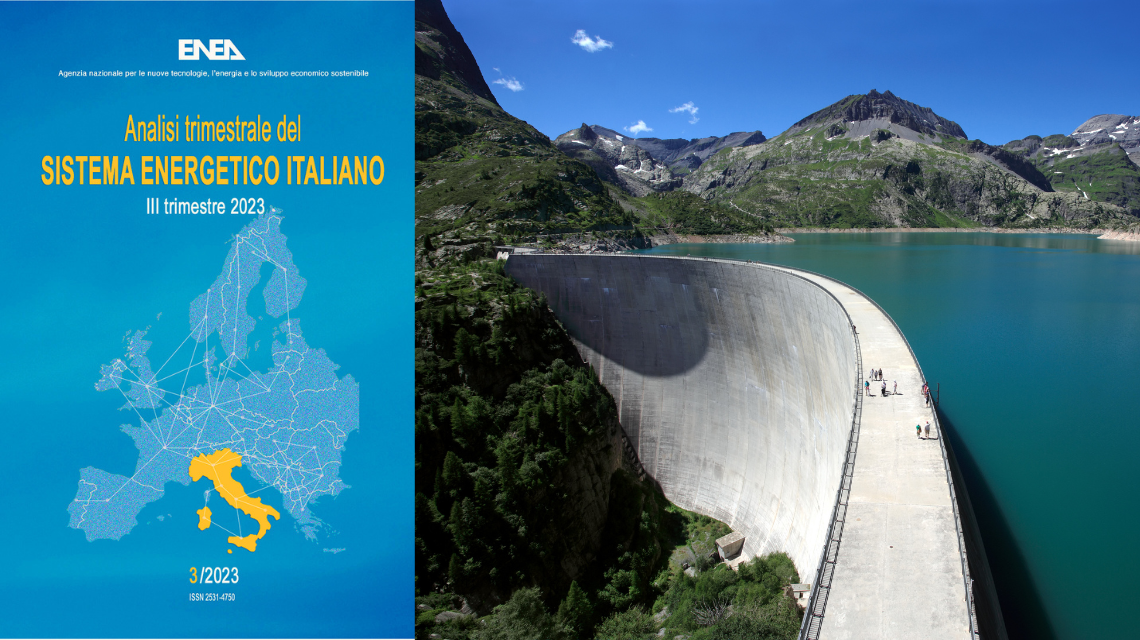Italian National Agency for New Technologies, Energy and Sustainable Economic Development

Energy: ENEA third quarter analysis, consumption stable but emissions falling (-8%)
Russian gas imports collapsed - Renewables energies increased
Consumption stable (-0.3%) in the third quarter of the year, a sharp contraction in CO2 emissions (-8%) due to a reduced use of fossil fuels and a substantial growth in renewables. Preliminary estimates for the whole of 2023 indicate a drop in consumption of around 3% and emissions of around 8%, as reported by the quarterly update of the ENEA Analysis of the Italian energy system, which also shows a clear improvement (+48% compared to 2022) in the ISPRED index[1] which measures the energy transition on the basis of prices, emissions and security of supplies.
“The data highlights that in the third quarter the trend in consumption is again in line with the trend in GDP, industrial production and the climate. In fact, the decoupling between the dynamics of energy demand and that of its main drivers recorded in the last year and a half has once again disappeared", pointed out Francesco Gracceva, who coordinates the ENEA quarterly analysis. “As concerns emissions, even in the third quarter of 2023 the decline was largely determined by the ETS sectors - i.e. energy-intensive industry and above all electricity generation (-15% compared to a year earlier) - while in the non-ETS sectors a decline of less than 2% is expected,” said the expert.
Regarding sources, in the third quarter the marginal decline in energy consumption was the result of a decline in fossil fuels of around 1.5 Mtoe (-40% use of coal) and an increase in renewables (+20%) for a slightly lower value, thanks mainly to the recovery of hydroelectric power. In the first nine months as a whole, the main driver of the overall drop in consumption of around 4.5 Mtoe was still gas (-5.5 Mtoe), followed by coal (-1.3 Mtoe; N.B.: partial data) and oil (-0.6 Mtoe), while significant increases were recorded by renewable electricity (+1.9 Mtoe, +10%) and net electricity imports (+1 Mtoe). In terms of sectors, the marginal decline in demand in the third quarter is due to a drop in industrial and civil electricity consumption, in line with industrial production and the GDP.
A positive fact is that the ISPRED synthetic energy transition index increased by 48% compared to the previous year, when however the index was at its lowest. The improvement is largely ralated to the performance of the decarbonisation component (thanks to a drop in emissions) and to a lesser extent to energy prices (which have decreased compared to the record levels of the second half of 2022). Renewable sources are also on the rise although, said Gracceva, "the increase in the share of RES in final consumption, which should reach the 20.5% target at the end of the year, exceeding the historical maximum of 2020, is not yet in line with the trajectory necessary to reach the new target of 40% by 2030”.
On the energy security side, despite the record level of storage filling (99% as of 1 November both in Italy and in the EU), next winter the satisfaction of consumption remains linked to the persistence of demand peaks well below the maximums. “In the event of prolonged cold peaks, critical issues could emerge,” said Gracceva. In the first ten months of 2023, in fact, the sharp decline in Russian gas imports (whose daily average fell to 8 million m3, compared to 77 in 2021 with almost a 90% drop) was compensated by significant increases of all other sources of supply (+16 million m3/day for LNG in 2023 compared to 2021, +14 million m3/d for gas from Northern Europe, +8 million m3/d for Algerian and Azerbaijani gas), “but the most important factor was a severe decrease in demand, whose daily average was cut by 30 million m3 (from 198 million m3/day to 168, -15%) in the first ten months of 2023 compared to the same months of 2021”, pointed out Gracceva.
Among the most critical aspects that emerge from the Analysis, there is a strong deficit in the trade balance of key technologies for decarbonization. In the first half of 2023 the deficit exceeded 3 billion euros, almost 80% of the deficit recorded in the whole of 2022, with the weight of the trade balance on GDP reaching 0.32% (it was 0.2% in 2022) . Imports of lithium ion batteries, photovoltaic panels and plug-in hybrid vehicles are especially important.
As for innovative capacity, the latest patent data shows that Italy's competitiveness in energy efficiency technologies also presents some risks. Faced with a growth in technological competition among countries at a global level and a rapid advance in the Asian area, Italy presents both strengths and weaknesses: the country's technological advantage is well consolidated in construction (with values of specialization index[2] consistently above 1.3 over the last twenty years), but declines in industry, with values just around unity in recent years. “Considering the industrial vocation of the Italian economy, this trend is particularly critical especially in comparison with Germany, which records an increase in specialization indices, with values above 1.5 in more recent years”, said Gracceva.
